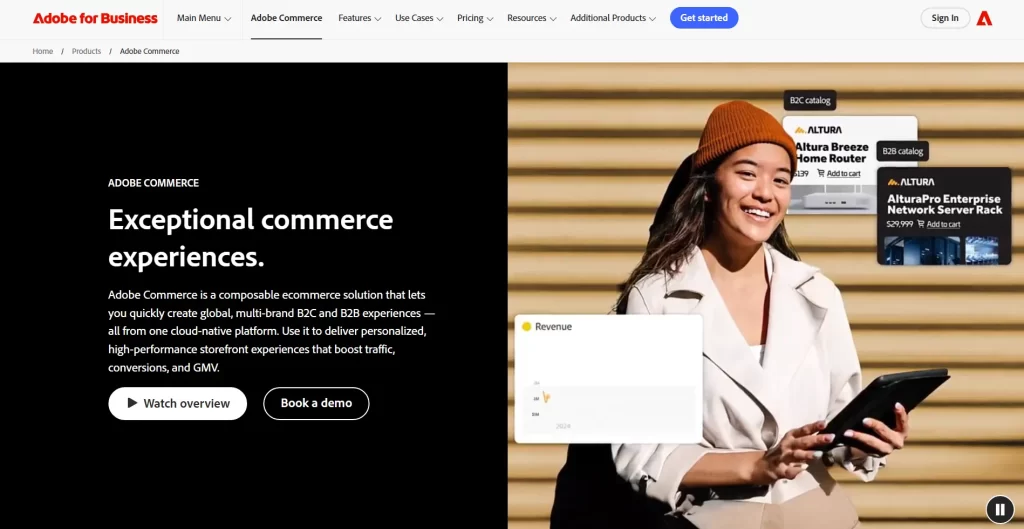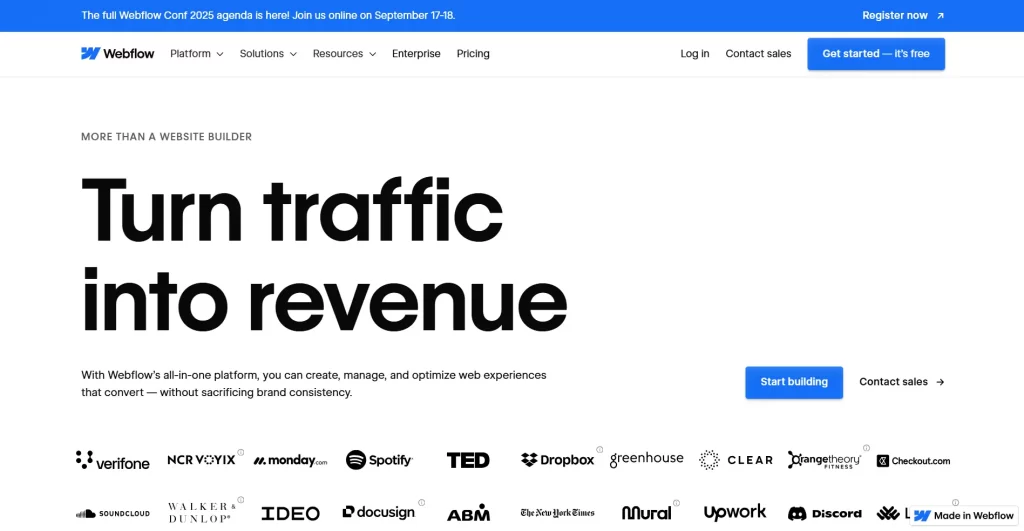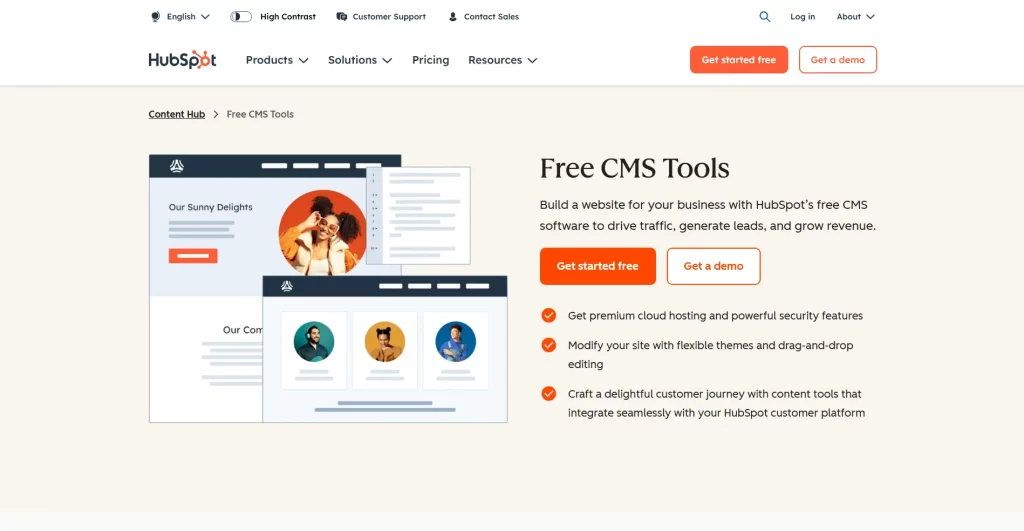- 1. WordPress.org – The Dominant CMS for All Websites
- 2. Shopify – Leading All-in-One Platform for E-Commerce
- 3. Wix – Fast-Growing Website Builder for Small Businesses
- 4. Squarespace – Polished Website CMS for Creatives and Entrepreneurs
- 5. Joomla – Veteran Open-Source CMS with Strong Community
- 6. Drupal – Enterprise-Grade CMS for Large and Complex Websites
- 7. Magento (Adobe Commerce) – Feature-Rich CMS for Online Stores
- 8. BigCommerce – SaaS E-Commerce CMS for Growing Brands
- 9. Webflow – Visual Web Design CMS for Designers and Marketers
- 10. HubSpot CMS Hub – Integrated CMS for Marketing-Focused Websites
- Conclusion
Modern businesses build their websites and online stores on robust content management systems (CMS). These platforms make it easy to create, edit, and publish content without needing advanced coding skills. CMS adoption is now widespread – roughly 70% of active websites use a CMS for their content management. With such a vast ecosystem, choosing the right solution is crucial. The best CMS platforms in 2025 offer powerful features, scalability, and ease of use, each catering to different needs (from simple blogs to large e-commerce sites). New statistics show the CMS market is still growing, with the top tools backed by thriving communities and continuous innovation.
To help navigate this landscape, we at 1Byte have compiled the top 10 CMS platforms in 2025 for building websites and e-commerce stores. Each platform below includes the latest stats, key strengths, and examples to illustrate why it stands among the best CMS platforms this year.
1. WordPress.org – The Dominant CMS for All Websites

WordPress is by far the most popular CMS in the world. It runs approximately 43 percent of all the websites in the internet, which makes it have a market share of approximately 61 percent in the CMS market. Its dominance is attributed to flexibility and a huge ecosystem of this open-source platform. WordPress allows site owners to create anything as simple as blogs to as complicated as e-commerce stores. It has more than 59,000 free plugins (extensions) and thousands of themes, so functionality and custom designs are practically limitless. WordPress is preferred because it is easy to use and has a large community of users. In addition, WordPress websites can readily incorporate online store capabilities through the WooCommerce plugin, in fact, approximately one-third of all online stores are powered by WordPress and WooCommerce.
The fact that WordPress is constantly being improved makes it relevant in 2025. Its block-based editor (Gutenberg) has developed into full site editing, which allows users to have greater design control without code. The platform also adopts the latest trends such as headless architecture and is compatible with SEO and performance tools. WordPress has a massive developer community and regular updates and thousands of tutorials, which means it is easy to get started with. In general, WordPress offers the best combination of strength and ease of use and that is why it is used by millions of websites as their CMS. It is the best option when one wants a tried and tested, internationally backed platform.
2. Shopify – Leading All-in-One Platform for E-Commerce

Shopify is the go-to CMS for online stores and one of the best CMS platforms for e-commerce in 2025. It is a fully hosted, commercial platform built specifically for selling products online. Shopify has seen tremendous growth – it now accounts for about 26% of the e-commerce platform market share by number of online stores. In the overall CMS realm, Shopify is the second most-used system after WordPress, powering roughly 4.8% of all websites on the internet. This translates to over 4.2 million live websites using Shopify as of early 2025. The popularity is driven by Shopify’s ease of use: merchants can set up a professional online storefront without technical expertise. Hosting, security, and software updates are handled by Shopify, so business owners can focus on products and sales.
Shopify has a wide range of in-built e-commerce functionality including inventory, payment, and shipping integrations. It has thousands of marketing, analytics, and other add-ons in its App Store. Also, Shopify themes are mobile-responsive and customizable, which means that brands can have their own storefront. A lot of successful shops are powered by Shopify – the platform serves both small startups and big brands. It is reliable and supports high traffic, particularly under the Shopify Plus plan that is used by businesses. To conclude, Shopify is a great option to use in case one requires a robust, but easy to use CMS that is optimized towards selling. It integrates powerful e-commerce features and an easy-to-use site builder, which enables online retailing to be available worldwide.
3. Wix – Fast-Growing Website Builder for Small Businesses

Wix has become one of the most popular CMS platforms over the last ten years. It began as a mere web site builder but has grown to become a powerful CMS with millions of users. The market share of Wix increased by 1,633 percent between 2015 and 2025, which is an unbelievable indicator of its global popularity. As of today, Wix is the CMS that is used by approximately 3.9 percent of all websites and has a market share of approximately 5 percent-5.5 percent, which places it in the top three in terms of usage. Wix has more than 7 million websites that are constructed on its platform. It is appealing because of the drag-and-drop interface and the all-in-one hosting. Wix is a visual drag-and-drop site builder, which is perfect for entrepreneurs, creatives, and small businesses.
Wix is distinguished by the flexibility of design and the choice of templates. The users have access to hundreds of stylish templates or they can create a blank canvas. The platform also has AI in the form of its ADI (Artificial Design Intelligence) tool, which can create a basic website based on user preferences. In 2025, Wix offers built-in blogging, portfolio, and even online stores (Wix Stores) features, and it has a market share of approximately 16 percent of the online store CMS market according to some estimates. Wix is not as sophisticated in e-commerce as Shopify, but it enables small retailers to sell. Moreover, Wix does the technical heavy lifting: the domain, SSL, performance optimization, and security updates are included. Wix is one of the best options to consider by users who want a stress-free CMS of a website. Its rapid growth and expanding capabilities underscore its status as one of the best CMS platforms for ease of use.
4. Squarespace – Polished Website CMS for Creatives and Entrepreneurs

Squarespace is another popular hosted CMS with beautiful templates and easy to use site builder. It drives approximately 2.4 percent of all websites and has an approximate share of 3.3 percent of the CMS market in 2025. There are more than 4.1 million websites using Squarespace. The platform is particularly favored by creatives, artists, and small businesses that care about aesthetics and branding. Squarespace has award-winning templates that are modern, responsive, and visually appealing right out of the box. These templates can be modified by the users through a drag-and-drop editor, changing layouts, fonts, and colors to match their brand. The outcome is a professional quality site without the need of a designer or developer.
In addition to being design-centric, Squarespace offers good content management capabilities. It allows blogging, portfolio galleries, podcast hosting and so on, all with an easy-to-use interface. Squarespace also offers e-commerce features to entrepreneurs – it has an e-commerce market share of approximately 11 percent (in terms of number of stores) as per the latest statistics. This implies that small businesses are able to sell goods or services on their Squarespace site, with inventory, payment, and order management features. All the processes are highly connected, such as marketing tools, like email campaigns and SEO settings. Customers rave about Squarespace being reliable and backed by support; as it is a closed platform, the technical side of things such as hosting, security and updates are all taken care of behind the scenes. In summary, Squarespace is one of the best CMS platforms in 2025 for those who want a stylish web presence with minimal fuss. It is a professional, worldwide utilized solution that focuses on the quality of design and simplicity.
5. Joomla – Veteran Open-Source CMS with Strong Community

Joomla is a long-standing open-source CMS that, while past its peak popularity, remains a powerful option in 2025. It was once the second most widely used CMS after WordPress and still retains a loyal user base. Joomla currently accounts for about 2% of CMS-powered websites (roughly 1.4% of all websites). Approximately 600,000+ active websites use Joomla today. This platform is maintained by a global community of developers and has a reputation for being robust and highly flexible. Joomla’s core is known for strong content management out of the box – it has a built-in multilingual system and advanced user access controls, making it suitable for complex sites with many contributors or languages.
Joomla is used by many organizations because it is easy to use and highly functional. It is more technical than WordPress and beginners, but it also has more native features without the need of as many plugins. Joomla has a wide range of extensions (both free and paid) to add functionality such as forums, e-commerce and social networks. Actually, Joomla can be used to run online stores with the help of extensions like VirtueMart or HikaShop. Although it has since been surpassed by other new entrants such as Shopify and Wix, Joomla remains one of the top five most used CMS platforms in the world. It is also very popular in Europe, with more than half of Joomla sites being registered there. Notably, Joomla has recently released version 4 that has enhanced SEO, security, and usability, making it stay in line with the current trends. Joomla is a professional choice with more than 15 years of community development that offers an alternative to WordPress to those who require a self-hosted CMS.
6. Drupal – Enterprise-Grade CMS for Large and Complex Websites

Drupal is a powerful and secure open-source CMS that governments, universities, and large businesses use. Although its total use is lower than more consumer-focused sites, Drupal is very popular when it comes to large, content-driven sites. It has approximately 1.2 percent of the CMS market share (approximately 0.8 percent of all websites), and is estimated to have 336,000 active sites using Drupal core. Drupal does not have a lot of numbers, but it has quality and impact. Remarkably, Drupal is the second most popular CMS (after WordPress) among the sites with high traffic – it is used by approximately 8.5 percent of the 10,000 most popular websites on the Internet. This figure is an indication of the strength of Drupal in dealing with large projects that require stability and customization.
Extremely flexible architecture is one of the main features of Drupal. It is modular; thousands of free modules enable developers to add functionality (e.g. to add custom content types, workflows, and integrations). The taxonomy and user permission systems in Drupal are highly granular and this is perfect when it comes to complex organizational websites. Security is another priority of the platform – Drupal has passed numerous security audits and is characterized by timely security updates (one of the reasons why government sites prefer it). In 2025, the current version is Drupal 10, which introduces an enhanced admin UI and updated code base (Symfony/PHP). Nevertheless, Drupal is also more difficult to learn and typically needs developer skills to reach its full potential. It is not as plug-and-play as WordPress or Wix to a casual user. Having said that, when it comes to enterprise websites, public sector portals, and others that have more complex needs, Drupal is frequently the best CMS recommendation. Its proven track record and ability to handle high complexity securely place it firmly among the best CMS platforms of 2025 for large projects.
7. Magento (Adobe Commerce) – Feature-Rich CMS for Online Stores

Magento is one of the most popular e-commerce CMS, which is characterized by a wide range of features and scalability. The open-source version of Magento (previously Magento Community Edition) and the paid Adobe Commerce version (after Adobe acquired Magento) are used by tens of thousands of online stores around the world. Magento has a large presence in the e-commerce market despite its relatively minor share of all websites (on the order of 0.5% or less of CMS-powered sites). By 2025, there are approximately 130,000 live websites powered by Magento. It is still among the 3 best self-hosted e-commerce platforms in the world, along with WooCommerce and PrestaShop. Magento is also used by many mid-market and enterprise retailers because it can support a large product catalog and high order volumes.
Magento has a full range of e-commerce features. Out of the box, it has support of multiple stores and languages, a wide range of product attribute options, powerful pricing rules, and various payment and shipping modules. It is highly customizable – developers can come up with custom themes and extensions to customize the shopping experience. Businesses frequently like the flexibility of Magento to integrate with other business systems (ERP, CRM, etc.) and the fact that it has a strong community that provides thousands of third-party extensions. Magento has been used by some of the major brands to operate their online stores, such as Skullcandy and Olympus, among others. The platform was not immune to the competition presented by SaaS competitors, but Adobe has been able to keep it in the game. Adobe Commerce (the enterprise cloud version of Magento) has even more features such as AI-driven product recommendations and advanced analytics. All in all, Magento is one of the best options in 2025 to choose as an e-commerce CMS that is self-hosted and powerful. It also needs more technical resources to operate than Shopify or BigCommerce but offers more control and scalability of the online storefronts to merchants.
8. BigCommerce – SaaS E-Commerce CMS for Growing Brands

BigCommerce is a well-known SaaS (hosted) CMS specializing in e-commerce, and is a competitor to Shopify as a retailer. Although it has less user base than Shopify, BigCommerce has a large number of online stores and is characterized by flexibility and powerful features. It is projected that by 2025, BigCommerce will support about 40,000-50,000 functioning online stores worldwide. This is approximately 0.2 percent of the total number of websites in terms of a content management system share. The niche of BigCommerce is also clear, as it frequently serves mid-size and enterprise brands that require more out-of-the-box capabilities and customization than the basic store builders can offer. As an example, such famous firms as Skullcandy, Vodafone, and Ben & Jerry use BigCommerce to host their official online stores.
Rich native functionality is one of the strengths of BigCommerce. It has an unlimited number of product variations, multi-currency, SEO-friendly site structure, and supports a large number of payment gateways and marketplaces. BigCommerce also comes with a powerful API, which makes it a good fit with headless commerce environments or custom front-ends and other software. BigCommerce also does not impose transaction fees on sales and is more flexible when it comes to third-party payment processors unlike Shopify. It is also a fully managed service which takes care of technical aspects (hosting, security, PCI compliance). Over the past few years, BigCommerce has been targeting bigger retailers with an enterprise plan and the ability to manage complex catalogs. Its multi-channel selling is another good characteristic; merchants are able to list on Amazon, eBay and Facebook, among other channels, via BigCommerce itself. Overall, BigCommerce ranks among the best CMS platforms for e-commerce in 2025, especially for merchants who want a hosted solution but require more advanced capabilities and customization than the typical beginner-level store builders.
9. Webflow – Visual Web Design CMS for Designers and Marketers

Webflow is a newer CMS that has attracted attention due to its different approach, which is a visual web design tool and a production-ready CMS. It can be considered as a site builder that allows designers to create custom, professional websites with a drag-and-drop interface, and the system generates clean HTML/CSS/JavaScript code automatically. By 2025, approximately 0.8 percent of all websites (approximately 1.2 percent of all websites using a known CMS) use Webflow. This means that there are almost a half a million websites (493,000+) that are powered by Webflow. It has a large number of creative agencies, startups, and marketing teams as its users who appreciate the freedom of design without manually coding everything.
The beauty of Webflow is that it creates a connection between the designers and developers. The Webflow Designer tool enables pixel-perfect layout control, advanced animations, and responsive layout, all visually. Meanwhile, Webflow also has an integrated CMS to manage dynamic content (such as blog posts, portfolios, product listings, etc.) using what they refer to as CMS Collections. Custom content types can be developed and templates can be designed easily. Webflow also has e-commerce: its e-commerce feature is still relatively new but allows users to create online stores with small to mid-sized catalogs, including shopping cart and checkout, all in the visual editor. Moreover, Webflow offers global CDN hosting, SSL, and quick page load times, which is convenient to those users who do not want to bother with separate hosting. To collaborate, there are team features and editors to ensure that the content managers can update site content without disrupting the design. In short, Webflow is considered one of the best CMS platforms for those who want full design flexibility and modern capabilities without writing code. It is especially good at marketing websites, landing pages, and other creative projects where custom design is important, but can also manage structured content and moderate e-commerce requirements.
10. HubSpot CMS Hub – Integrated CMS for Marketing-Focused Websites

HubSpot CMS Hub is a cloud-based content management system that is a component of the greater HubSpot ecosystem (comprising CRM, marketing, and sales tools). It has become very popular in usage by businesses who wish to have their site integrate closely with marketing automation and customer data. In 2025, approximately 0.2 percent of all websites use HubSpot CMS, a relatively small, but significant percentage in the context of a newcomer in the CMS market. HubSpot claims that it has more than 190,000 customers in 120+ countries in total (CRM, CMS, etc.), which is a good sign of its global presence. The CMS Hub specifically has become popular with marketing teams due to it being an all-in-one solution: you can create and edit your web site content, and take advantage of HubSpot built-in SEO suggestions, forms, analytics, and personalization capabilities all in one place.
The distinguishing feature of HubSpot CMS is its close connection with customer relationship management. Each page and blog post has access to the Smart Content functionality in HubSpot, so the site can present different content to a visitor depending on their previous interactions with the site or their demographics (such as presenting different messaging to a lead versus a first-time visitor). The CMS Hub offers an easy-to-use drag-and-drop editor and adaptable themes to design mobile-friendly pages. The CMS is the final piece of the puzzle to companies that have already implemented the marketing or sales modules of HubSpot: the leads and contacts generated on the site will be automatically passed to the CRM and content performance can be monitored through the entire process. The second advantage is that HubSpot CMS is fully hosted and highly secure and automatically updated, just like other SaaS products. It has such features as built-in A/B testing, SEO optimization recommendations, and great security (it has a security team and enterprise-level infrastructure). Although HubSpot CMS does not provide the same flexibility of open-source platforms, it is ideal when the focus is on marketing-driven websites where the lead generation and content strategy are the primary goals. HubSpot CMS Hub is frequently the most suitable option when companies desire a dependable, simple to control site that fits into email marketing, analytics, and CRM smoothly.
Leverage 1Byte’s strong cloud computing expertise to boost your business in a big way
1Byte provides complete domain registration services that include dedicated support staff, educated customer care, reasonable costs, as well as a domain price search tool.
Elevate your online security with 1Byte's SSL Service. Unparalleled protection, seamless integration, and peace of mind for your digital journey.
No matter the cloud server package you pick, you can rely on 1Byte for dependability, privacy, security, and a stress-free experience that is essential for successful businesses.
Choosing us as your shared hosting provider allows you to get excellent value for your money while enjoying the same level of quality and functionality as more expensive options.
Through highly flexible programs, 1Byte's cutting-edge cloud hosting gives great solutions to small and medium-sized businesses faster, more securely, and at reduced costs.
Stay ahead of the competition with 1Byte's innovative WordPress hosting services. Our feature-rich plans and unmatched reliability ensure your website stands out and delivers an unforgettable user experience.
As an official AWS Partner, one of our primary responsibilities is to assist businesses in modernizing their operations and make the most of their journeys to the cloud with AWS.
Conclusion
All of these top 10 CMS platforms in 2025 are good in their own way and the final decision of which one is best should be based on the project needs. The sheer size of the ecosystem means that WordPress is a generalist content site and e-commerce (with WooCommerce). Shopify and BigCommerce are the leaders in case you require a turnkey e-commerce solution that has strong store management capabilities. Hosted builders such as Wix and Squarespace are best at simplicity and design when it comes to simple brochure sites or portfolios. Joomla and Drupal are more complex in their needs, they are preferred when stability, advanced permissions, or enterprise-level customization is needed. Magento is unique to big online stores that desire to have a complete control of their shopping site. In the meantime, new solutions such as Webflow fill the gap between design and development, and HubSpot CMS is focused on marketers that are interested in having their site connected to lead-generation tools.
In summary, the best CMS platforms of 2025 empower users to create engaging websites and online stores with relative ease. They use the most up-to-date web technologies, including mobile responsiveness, SEO optimization, and even AI-powered features. Regardless of the platform a business uses, it is evident that CMS software still powers most of the websites today and it will still be advancing to support the increasing needs of the digital world. Organizations can make a confident choice of a CMS that suits their objectives by analyzing such criteria as scalability, usability, extensions, and support community. All of the tools mentioned here are tried and tested solutions that can be used to create a successful web presence or e-commerce presence in 2025 and beyond.

